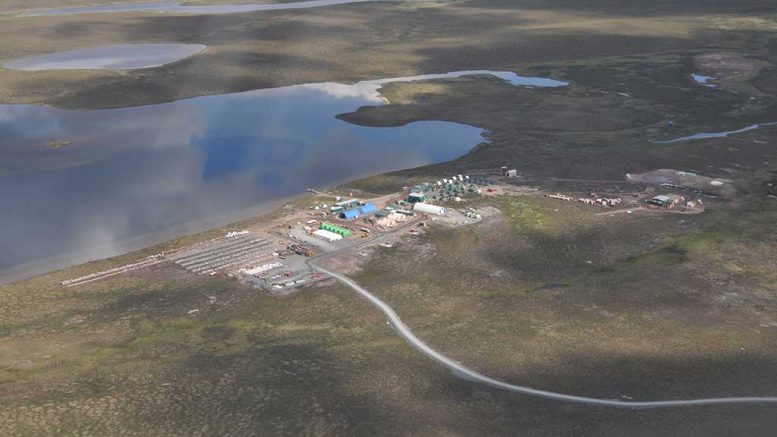VANCOUVER — Sabina Gold & Silver (TSX: SBB; US-OTC: SGSVF) hopes to start construction at its multimillion-ounce Back River gold project in mid-2018 after having received a positive recommendation from the Nunavut Impact Review Board (NIRB).
Territorial regulators had rejected the company’s initial application 12 months ago due to concerns that related to the regional Bathurst caribou herd, mine closure measures and broader wildlife protection efforts.
The NIRB approval on July 18, follows five years of review and public hearing processes involving local Inuit, the Kitikmeot Inuit Association, federal and territorial governments, and other community and northern representatives.

A community meeting in Gjoa Haven, 1,056 km due northeast of Yellowknife, Northwest Territories, in June 2012. Credit: Sabina Gold & Silver.
“We didn’t need to alter our mine design. Instead we’ve made changes to our management plans,” Sabina’s vice-president of environment and sustainability Matthew Pickard says during an interview.
“This includes wildlife protection measures and other areas where we provided more clarity and specifics. We went beyond what you’d typically see in an environmental process to increase everyone’s confidence. Any cost increases, or related impacts on project economics, are likely minor. There might be a little more cost in terms of environmental monitoring and mitigation.”

Environmental concerns relating to Nunavut’s regional Bathurst caribou herd stalled mine construction at Sabina Gold & Silver’s Back River gold project last year. The company considered caribou migration and calving activities in its subsequent application. Credit: Sabina Gold & Silver.
The approval is subject to 94 terms and conditions that include an Inuit environmental advisory committee, a caribou technical advisory group and measures for the “staged reduction of project activities, as well as rapid and planned operational shutdowns, should caribou occur in proximity to the project site.” Agnico Eagle Mines (TSX: AEM; NYSE: AEM) had 30% more conditions attached to its Meliadine gold project 25 km north of Rankin Inlet back in 2015.

Matthew Pickard, Sabina’s vice-president environment and sustainability. Credit: Sabina Gold & Silver.
Pickard points out that based on Inuit traditional knowledge and government scientific data, the Bathurst herd doesn’t interact with the project site. He says that any mine shutdowns would likely last “a couple days,” based on caribou migration, and calving and post-calving activities.
The company reportedly has the Ahiak-Beverly herd in the project region during “the summer months.” The NIRB conditions for caribou do not differentiate by herd.
“We have plans that reduce certain activities around the mine if caribou are in the area, including blasting and heavy equipment,” Pickard says.
“During sensitive periods, like calving and post-calving, we may do an operational shutdown. That doesn’t mean the entire mine, because the mill and inside activities can continue, the crusher can continue and the loader at the mill can continue,” he says.
Back River lies 520 km northeast of Yellowknife, N.W.T., and hosts measured and indicated resources of 28.2 million tonnes grading 5.87 grams gold per tonne for 5.3 million contained ounces.
Sabina released a feasibility study on the project in late 2015 that models a 3,000-tonne-per-day operation. The mine would produce 198,000 oz. gold per year over an 11-year life at all-in sustaining costs of US$620 per ounce. The NIRB ruling assumes a 27-year project footprint that takes closure into account.

Sabina’s Goose gold property at the Back River project in Nunavut. Credit: Sabina Gold & Silver.
Initial capital is an estimated $415 million, while sustaining capital sits at $185 million.
“It doesn’t alter much from our mining perspective because the operational design is heavily based on stockpiles. We’re not as dependent on the mill feed coming continuously from the mine site,” Pickard says.
“The gold production should stay the same, but you may see a minor head grade variation. We don’t anticipate losing much more than one or two days per year as a result of all the mitigation measures. We don’t believe it will have much, if any, impact on Back River’s economics.”
The positive NIRB report has been forwarded to federal Minister of Indigenous and Northern Affairs Carolyn Bennett for a decision. If Bennett accepts the recommendation, Sabina will apply for construction and operation.

Winter drilling at the Goose property at Back River. Credit: Sabina Gold & Silver.
The company intends to submit Type A and Type B water licence applications to the Nunavut Water Board within the next 60 days.
On July 20, Sabina announced it would add 6,000 metres of drilling to its annual exploration plans at Back River to bring the program to 13,000 metres. The company is targeting resource expansion at its Goose property that it says could “enhance economics.”
Sabina shares gained nearly 14%, or 28¢, after news of the NIRB announcement, en route to a 52-week high of $2.34 per share at press time. The company has 224 million shares outstanding for a $523-million market capitalization, and reported $43 million in cash and equivalents at the end of March.
“The outstanding feasibility study remains accurate,” Pickard says. “We’ve had time to plan the way forward over the past year, including advancing project financing and securing our permits. We hope we can start initial mobilization and construction by March 2018.”


Be the first to comment on "Sabina back on track at Back River after NIRB approval"